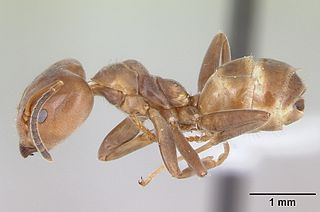
Dolichoderinae is a subfamily of ants, which includes species such as the Argentine ant, the erratic ant, the odorous house ant, and the cone ant. The subfamily presents a great diversity of species throughout the world, distributed in different biogeographic realms, from the Palearctic, Nearctic, Afrotropical region and Malaysia, to the Middle East, Australian, and Neotropical regions.

Acropyga is a genus of small formicine ants. Some species can be indirect pests. A. acutiventris, which is found from India to Australia, tends subterranean, root-feeding mealybugs of the species Xenococcus annandalei. Living, gravid females are carried in the jaws of A. acutiventris queens during their nuptial flight, to establish the symbiotic association in founding colonies. Other Acropyga species have relationships with different species of mealybugs, and it could be a trait common to the whole genus.

Joseph Charles Bequaert was an American naturalist of Belgian origin, born 24 May 1886 in Torhout (Belgium) and died on 12 January 1982 in Amherst, Massachusetts.

Procryptocerus is a Neotropical genus of gliding ants, with the ability to "parachute" by steering their fall if they drop off of the tree they're on.

Azteca is a strictly Neotropical genus of ants in the subfamily Dolichoderinae. The genus is very diverse and contains around 84 extant species and two fossil species. They are essentially arboreal and many species have mutualistic associations with particular plant species, where the genus Cecropia presents the most conspicuous association. In the Brazilian Amazonia, Azteca species are associated with species of Codonanthopsis.

Azteca adrepens is a species of ant in the genus Azteca. Described by Auguste-Henri Forel in 1911, the species is endemic to Paraguay.
Azteca aesopus is a species of ant in the genus Azteca. Described by Auguste-Henri Forel in 1908, the species is endemic to Brazil.

Azteca alfari is a species of ant in the genus Azteca. Described by Carlo Emery in 1893, the species is widespread in Mexico, Central and South America. This ant has a mutualistic relationship with a Cecropia tree. The specific name alfari honours a Costa Rican zoologist Anastasio Alfaro.
Azteca angusticeps is a species of ant in the genus Azteca. Described by Carlo Emery in 1893, the species is widespread in North America and South America.
Azteca aurita is a species of ant in the genus Azteca. Described by Emery in 1893, the species is widespread in North America and South America.
Azteca barbifex is a species of ant in the genus Azteca. Described by Auguste-Henri Forel in 1906, the species is endemic to North America and South America.
Azteca beltii is a species of ant in the genus Azteca. Described by Carlo Emery in 1893, the species is endemic to North America and South America.
Azteca brevis is a species of ant in the genus Azteca. Described by Auguste-Henri Forel in 1899, the species is endemic to Costa Rica and Nicaragua.
Azteca christopherseni is a species of ant in the genus Azteca. Described by Forel in 1912, the species is endemic to Panama.

Azteca coeruleipennis is a species of ant in the genus Azteca. Described by Emery in 1893, the species is endemic to several countries in North America and Central America.
Azteca cordincola is a species of ant in the genus Azteca. Described by Forel in 1921, the species is endemic to Bolivia.
Azteca coussapoae is a species of ant in the genus Azteca. Described by Auguste-Henri Forel in 1905, the species is endemic to Brazil.
Azteca delpini is a species of ant in the genus Azteca. Described by Emery in 1893, the species is endemic to South America.
Azteca depilis is a species of ant in the genus Azteca. Described by Carlo Emery in 1893, the species is endemic to South America.

Azteca muelleri is a species of ant in the genus Azteca. Described by the Italian entomologist Carlo Emery in 1893, the species is native to Central and South America. It lives in colonies in the hollow trunk and branches of Cecropia trees. The specific name muelleri was given in honour of a German biologist Fritz Müller, who discovered that the small bodies at the petiole-bases of Cecropia are food bodies.







